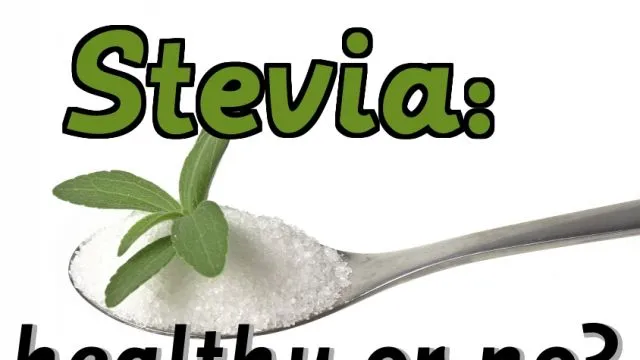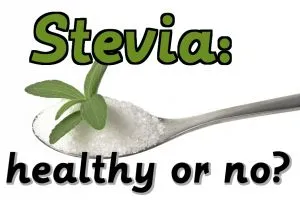
- Share on Facebook295
- Share on Pinterest
- Share on Twitter
Stevia is a highly convenient calorie-free sweetener, which is naturally derived. It dissolves easily and is affordable, so a lot of health-conscious folks have flocked to stevia as a go-to sugar alternative.
Possible health benefits include the following:
- Stevioside, the bitter part of the stevia leaf, increases the death of cancer cells while down-regulating certain stress processes that contribute to cancer growth.
- Stevia contains antioxidants and can be synergistic with other antioxidant anti-cancer compounds, such as blackberry leaf.
- By removing sugar from the diet, fasting blood glucose can be normalized, possibly helping those with obesity or diabetes.
Unfortunately we find that when we look beneath the surface, this popular health food may not be the harmless sweet angel we think it is. The body is complex, and stevia may cause underlying imbalances to hormones and blood sugar.
Let’s first review the different types of stevia on the market.
Green leaf stevia: This is essentially the whole stevia leaf, dried and ground into a powder so all the natural constituents remain. This is the way stevia is used traditionally in South America and Japan. This type of stevia is only 30–40 times sweeter-tasting than sugar.
Extracted stevia: The bitter-tasting constituent (stevioside) is removed, leaving only the sweeter-tasting rebaudioside. This version is likely to lose the health benefits associated with stevia, since these are thought to come mainly from the stevioside. The result is about 200 times sweeter than sugar.
Chemically-processed stevia: Popular brands of stevia tend to be this type. The natural stevia is subjected to a 42-step process to create a highly refined extract, using chemical solvents and GMO additives. This type is 300–400 times sweeter tasting than sugar.
From this basic analysis we can see that it’s probably safer to stick with stevia as traditionally used in its minimally processed form. The extracted form may be relatively safe as well, but all the potential health benefits are lost.
However, beyond the obvious marketability of a sweet-tasting substance that appeases the palate but doesn’t raise blood sugar, it’s wise to examine more subtle effects on the body.
One major concern is that stevia taxes the adrenals. These are the glands which produce cortisol, the important hormone that allows us to wake up in the morning and experience a healthy stress response, which is vital for our adaptation and survival.
 The problem is that stevia tricks the adrenal glands into a perceived state of hypoglycaemia. According to Clinical Nutritionist Kate Skinner, “Stevia is sweet on the palate, so the body assumes it is receiving sugar and primes itself to do so.
The problem is that stevia tricks the adrenal glands into a perceived state of hypoglycaemia. According to Clinical Nutritionist Kate Skinner, “Stevia is sweet on the palate, so the body assumes it is receiving sugar and primes itself to do so.
Glucose is cleared from the bloodstream and blood sugars drop, but no real sugar/glucose is provided to the body to compensate. When this happens, adrenaline and cortisol surge to mobilize sugar from other sources (liver and muscle glycogen, or protein, or body tissue) to bring blood glucose back up.”
A further concern is that stevia may alter other hormones that play important roles in fertility and immunity. Its chemical structure comes from a hormonal pathway, which could cause it to interact with receptors meant for the body’s own hormones. Stevia has been traditionally used as a contraceptive, and has been shown to influence fertility in animal studies.
When there are so many other delicious sweet-tasting foods to enjoy, the complex effects and potential unknowns of stevia just don’t seem worth the risk. Opt for moderate amounts of raw honey or coconut sugar instead, or use dates or bananas to sweeten your recipes.
-The Alternative Daily
Sources:
http://www.nutritionbynature.com.au/1/post/2013/02/q-a-mondays-stevia-quinoa-almond-milk.html
http://www.thepaleomom.com/2013/03/teaser-excerpt-from-the-paleo-approach-the-trouble-with-stevia.html
http://draxe.com/stevia-side-effects
http://www.ncbi.nlm.nih.gov/pubmed/10619379
http://www.newhealthguide.org/Stevia-Side-Effects.html
- Share on Facebook295
- Share on Pinterest
- Share on Twitter

